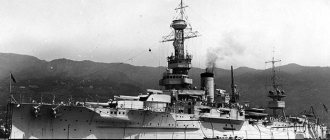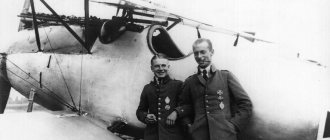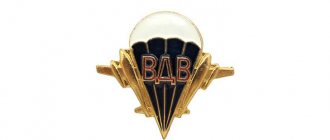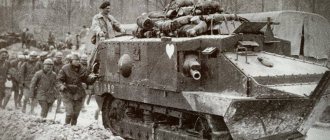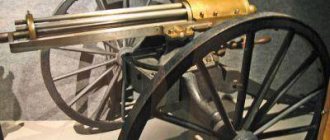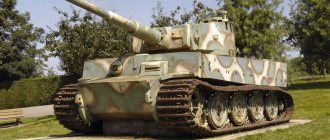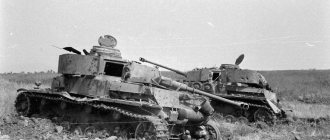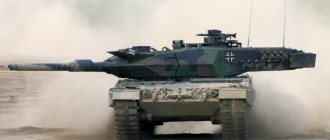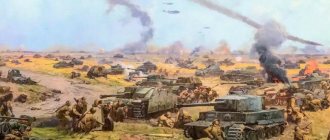Design and armor of Bayern-class battleships
The ship's hull had an enlarged forecastle, which occupied 2/3 of the ship's length. Reservation of additional superstructures required an increase in the total displacement; when fully loaded, it exceeded 31 thousand tons. The length of the Bayern was 179.8 m. The thickness of the protective plates remained the same as on previous König-class battleships, and in the most vulnerable places reached 350 mm.
Eight spotlights provided visibility at night. During the day they were lowered into armored rooms. If necessary, the water pumping system was turned on, which consisted of five autonomous groups. Thus, even after receiving a hole, the dreadnought could continue to function. In case of a serious accident, the counter-flooding function was used. It took no more than 15 minutes to correct the roll by 5 degrees.
German designers paid great attention to underbody protection. Anti-torpedo defense compartments were located along the entire length of the ship. As a result of the unique design of these compartments, a torpedo that hit a target dissipated energy and the ship received minor damage.
German battleship tier 6 Bayern. Unhappy Bavaria.
Date: 10/20/2016 | Posted in Battleships, Reviews | |
At level 6, in the camp of battleships, through one, the kingdom of imbs is observed. Fuso, New Mexico, Arizona are frankly good. Other premium brothers, although not so flexible, at least have their own chip through which they play. How does Bayern live among all this diversity? We'll find out in our review today.
I’ll say right away that the review this time will be highly subjective. So, if Bavaria suits you and you don’t agree with me, that’s normal.
Let's move on to performance characteristics.
TTX
Artillery Main Corps
The main thing that makes Bayern stand out at its level is its large caliber. 380 mm, which is 30 more than most competitors. After 305 mm König, this caliber looks brutal, in your mind’s eye you’ll already one-shot some Mexico, knocking out 6-7 strongholds, receive a “crushing blow” and proudly, with a feeling of a job well done, retire into the sunset, leaving behind the smoking and sinking debris. Reality, as always, unceremoniously smashes your face on the table, making you cry tears of blood from the next salvo at 1090.
The fact is that the 380 mm caliber is excessive for its level. Enemy cruisers won’t even pay attention to another hole in their citadel. The projectile flew through the entire citadel, probed the insides of a couple of boilers, and added a number of holes to the energy systems. It’s okay, because the main thing is that he left the ship, so you get your well-deserved 1090, and the sailors of some Cleveland will quickly plug a few extra holes in the boilers with rags. Delov then.
Ok, it doesn’t work with cruisers, but you can try to kill battleships! They have a lot of armor, the projectile will not fly away in a draft, and the large caliber will allow them to knock out the citadel.
But here accuracy will have its say. Bayern is as precise as an over-beer-drinking 60-year-old Fritz at an Oktoberfest trying to get into a hole in a public toilet. As you understand, it doesn’t matter to him, to put it mildly, most of the former beer ends up on the floor, and not at all in the hole intended for it.
Actually, according to my suspicions, the entire team of Bayern gunners consists of these 60 year-old Krauts who celebrate Oktoberfest all year round. Because Bayern doesn't hit at all. It doesn’t matter whether the target is 5 km away from you or 15 km away, the result will be the same: Merry plops around the enemy ship. The malicious face of the enemy captain presenting a protruding index finger and thumb to his forehead - the letter L denoting Loser (loser). Well, an emergency change of your chair to a new one from a pack standing nearby. Stock up on chairs, you will need a lot of them.
Mexico and Fuso are good because they don't care about accuracy. The excellent weight of a salvo of 12 shells allows you not to worry too much, at least something will hit. Bavaria has only 8 guns, and the accuracy is like a shotgun.
In Bayern, the Civil Code is tipped off by his relatives
At the same time, the remaining performance characteristics of the guns are by no means amazing. The rate of fire is standard battleship, 2 rounds per minute, the difference from classmates is cosmetic. The towers rotate 180 degrees for 51 seconds, not to say that very quickly. The projectile's flight speed is not outstanding, 800 m/s. Ballistics, respectively, too. The firing range is 17.7 km, but Bayern doesn’t really need it when the gunner can’t even throw a cigarette between his teeth, for some reason it only hits the ass.
PMK
So maybe the not outstanding main caliber is compensated by a powerful secondary gun that burns out everything in its path? In the end, the German battleships are unbalanced by Lesta as melee battleships.
But even here there is disappointment. No, Bayern has a PMC and compared to its competitors it’s really not bad. But competitors don’t need this PMC; they quickly and decisively achieve all goals even before this very PMC can work. The firing range of Bavaria's secondary guns with the appropriate build will reach 7.2 km, but at such a distance it will be more of a beautiful fireworks display than a formidable weapon.
Anti-mine guns can help in combat with an enemy battleship at close range. But here, too, salvos with main battery guns will be of primary importance, as they inflict monstrous damage at pistol ranges. Therefore, the general verdict on the PMC remains unchanged. Yes, unlike competitors, at least it exists. But it's not much use.
Air defense
What Bayern was not deprived of was air defense. Traditionally for the Germans, a strong long-range aura confidently mows down aircraft of the same level Aviks even on approach.
In general, Bavaria's air defense is even stronger than that of Mexico, and for Tier 5-7 Aviks it really becomes a big problem. But the level 8 aviks frankly wanted to sneeze at your air defense, and Saipan with axes from level 9 will be able to fly in your auras as much as he wants.
Therefore, carefully look at Aviks in team compositions at the very beginning of the battle.
Vitality
At the top, Bayern has 51600 HP. The lowest value among all tier 6 battleships. This is especially surprising, since a productive game in Bayern involves actively reducing the distance and fighting in close combat. That is, you will have to directly catch enemy torpedoes, landmines, armor-piercing shells, tank in every possible way, and for this you have... Yes, the smallest number of combat effectiveness points.
Okay, to hell with HP. Maybe the armor is such that you can at least ignore enemy AP? Not at all, if you substitute the side, you’ll get 10 thousand from any 350 mm carrier. If the enemy has 380 mm, then the matter will not be limited to white damage, you will get it directly into the stronghold. And I don’t even mention the fact that we often encounter opponents with a caliber beyond 400 mm.
You won't be able to tank landmines either. Bayern has huge superstructures that occupy the entire central part of the ship and it is problematic to miss them.
Well, maybe torpedoes aren’t scary? Not at all, PTZ cuts only 21% of damage. This means that from a hypothetical torpedo at 10K, you will receive 7.9K damage. Considering that torpedoes rarely travel one at a time, the risk of cutting off half of your face remains very high.
Maneuverability
The rudder shift time is at the level of classmates, with modernization 11.1 s. The circulation radius is also not amazing, 630 m. This, of course, is not the worst indicator, but Bavaria is far from the level of Warspite, which unfolds on a patch.
Maximum speed 25 knots. In this, Bayern is the leader among all pumped LK 6, with a gap from its closest competitor... By half a knot.
But in reality, everything is bad here too. While his classmates, having swum to 18-20 km, can already open fire and bring at least some benefit, Bayern still has to scratch and scratch until he starts shooting, at least with some efficiency. In addition, playing in close combat means that sooner or later you will have to retreat when your HP starts to run out. And 25 knots of maximum speed means that you will not be able to quickly retreat, and most likely you will die under fire. While the allied Fuso will calmly attack from 20 km.
Disguise
Lights up from Bavaria ships from 14.9 km. Of course, it’s a long way from Fusovsky’s record 19 km, but this figure cannot be called small either.
Builds
Since in the last vote they persistently hinted to me that an analysis of perks and upgrades would not be superfluous, the question of adding this section to the review was not raised.
I could simply list the perks and upgrades I have installed, but I hate this approach. Therefore, let’s look in a little more detail at what to put and what it will lead to.
On German LKs, I see 3 builds relevant: universal, secondary gun, air defense.
Perks
1 lvl. BOP. Standard for all personal accounts. We are strengthening air defense and secondary guns. OBZH to taste, but I limit myself to just a gold strap.
2 lvl. Master gunner. There's nothing more anyway. I don’t even consider fire protection as an option; its effectiveness is close to 0.
3 lvl. There is also no alternative to the superintendent .
4 lvl. UOP. The secondary gun/air defense range will be useful in any case. Air defense build: RUPVO. If you have chosen air defense as a priority, download the RUPVO first and only then the OPS. Bayern's long-range aura contains basic damage - 99 units/s. With RUPVO it will be already 198 units/s.
5 lvl. PMK build: RUPMK. Obvious, right?
Modernization
1 slot. Support caliber survivability. The towers of the Bayernu Civil Code are not knocked out often, and the cellar is blown up even less often. And at least we won’t be left without air defense/secondary guns by the middle of the battle.
2 slot. A key slot that mostly delimits builds. Universal: Precision mod. At least somehow we correct the wild crookedness of our guns. It helps, alas, little. Air defense. The distant aura will hit 7.2 km. It will be very difficult to reach you. PMK. The range of the secondary guns will be the same 7.2 km.
3 slot. SBZZH. The steering wheels and engine were knocked out on my LC for the last time... Never.
4 slot. Steering wheels. 14 seconds of transfer without a module is quite a lot. 11.1 is just right.
Of all the options proposed above, I chose the universal build. Air defense is good, but Bayern doesn’t suffer from Aviks, and this build still won’t help from Lex’s raid.
The secondary weapon build looked interesting, but in practice it showed its relative uselessness. In addition, it requires 5 perks, which on Bayern will be available not only to those who bought Tirpitz.
That's why I replaced 2 mods and played in the universal version. Not to say that the accuracy of the modernization has increased significantly, but Bayern is the case when any increase will be in place.
This was a pilot version of the analysis of perks and upgrades; criticism, suggestions and other comments are accepted.
Tactics
How to play on this? First of all, stock up on chairs. Booze won't be amiss either. Because it is absolutely impossible to play sober while obscene German songs are heard from the guidance post.
A typical Bayern captain and his ship
Once you are balanced in pain, pay attention to the team compositions. If you have 8 against you, everything is bad. Dive behind the islands, don’t go forward, shoot from 15 km. The efficiency will be so-so, but the only alternative will be a quick shipment to the port from any mimofubuki.
The most favorable situation is getting to the top or 7 levels. This does not mean at all that you can quickly run forward by raising a pirate flag. Try to stay at the leading edge of the front, somewhere behind the destroyers, among the cruisers.
Ideally, you should choose a flank where the terrain allows you to SUDDENLY appear in front of the enemy team. Let's say one of the flanks on 2 brothers is quite suitable for this. It is then that, unexpectedly appearing from behind the island, you will have the opportunity to inflict a lot of damage with your oblique shotguns, while the enemy team turns the steering wheel around.
Anti-class
Destroyers
The best thing Bayern can do when he sees a destroyer is to hang up the secondary gun focus and run away. If a cormorant is playing on the destroyer, which, contrary to all logic, began to chase us, our secondary gun will destroy it sooner or later. Don’t even rely on the main battery; in those rare cases when you can hit, the damage will be standard - 1090.
In general, when playing in Bavaria, carefully monitor the minimap and the location of enemy destroyers. Since you have to act on the first line, a sudden meeting with a joyful destroyer taxiing from behind the island is commonplace. And at the time of such a meeting, we must already be completely ready - turned stern and with landmines in the trunks.
Cruisers
The fight against cruisers on Bayern is primarily a fight against randomness. Bayern is capable of carrying cruisers forward feet first, hitting 20 thousand at once. However, no one knows when randomness will favor you and your shells will deign to hit and “get stuck” in the enemy stronghold. This means that even Mioko, completely turned sideways towards you, 10 km away, is not tasty food, but only a small probability of getting it. Although, most likely, based on the results of the volley, you will either not hit or get 2 drafts. That is, Bayern is not even able to punish an enemy cruiser for a mistake.
Battleships
The armor penetration of 380 mm shells is enough to pull out citadels from level 8. But this does not make Bayern a good hunter of enemy LKs.
We have already considered the first reason. You need to hit these LCs.
The second is that you need to somehow survive under return fire.
Third, enemy LKs will open fire on you long before you can reach them. I’m not saying to confidently hit, the question is simply to finish shooting at them.
Therefore, everything will depend on your skill. If you SUDDENLY get within a short distance of the enemy’s LOC, then you will have every chance of taking it. But, if the firefight started from a distance, you will be the one to grab it.
Aircraft carriers
Actually, almost everything about aircraft carriers has already been said earlier. Level 5-6 Aviks are not scary at all. A competent maneuver will allow you to avoid a ton of damage, and even if the air groups fly back, it will be in a very reduced state. Ordinary level 7 Aviks are already more terrible, but they will also suffer. Saipan is bent over money with concrete planes, it doesn’t care about air defense. Although Shokaku reclines, some group may end up missing out. It's basically impossible to fight off Lex.
As a conclusion
After reading the review, you might think that everything is terrible. Bayern doesn't hit, doesn't move, and is generally only good at air defense. This is actually not entirely true.
Despite the fact that in many characteristics this ship is inferior to its classmates, it still remains a battleship. Yes, oblique, yes, very short-range. But still a battleship.
This means that he is quite capable of completing his tasks. Push the direction. Threaten the enemy cruisers with your salvo (even if it hits badly, it will have a psychological effect). Deal main damage to the enemy's LK. Take the flying midges onto your umbrella, thereby covering your allies.
The problem is that his classmates can perform all these same tasks with no less efficiency. At the same time, leaving in reserve such individual bonuses as: firing range and survivability (Fuso), air defense and armor (Mexico). This is not to mention the fact that they have 12 guns.
It turns out that Bayern looks faded against their background. The few advantages that he got simply do not compensate for his monstrous disadvantages and make him simply unnecessary at his level.
Author of the publication
offline for 4 weeks
Bes
Comments: 8542Publications: 388Registration: 06/11/2016
Armament
The Bayern dreadnought had the following types of guns:
- 8 heavy 380 mm naval guns, located in pairs on tower superstructures. Each gun included 60 armor-piercing and 30 high-explosive shells.
- 16 150 mm anti-mine installations installed in casemates on the upper deck. The predecessor of the described battleships had 14 medium guns. The combat reserve was 160 rounds for each gun.
- Anti-aircraft artillery was represented by 88-mm Flak L/45 C/13 guns. It was planned to install 8 units of equipment. However, at the time of commissioning, the ships were equipped with only one pair of anti-aircraft guns. After a year of service, their number was increased to 4.
- 5 600 mm torpedo tubes.
Notes[edit]
- Battleship portal
| Wikimedia Commons has media related to Bayern-class battleships . |
Footnotes [edit]
- All German ships were ordered under temporary names; additions to the fleet received the letter, while ships that were to replace older vessels received the order as "Ersatz (ship name)." An example of this practice is the Derfflinger class battlecruisers: the lead ship SMS Derfflinger was considered an addition to the fleet and was designated "K", while her sisters Lützow and Hindenburg were named Ersatz Kaiserin Augusta
and
Ersatz Hertha
, being replacements for two older ships. See: Gröner, p. 56. - Metacentric height (the distance between the center of gravity - G - and the metacenter - M - abbreviated GM) determines the tendency of a ship to roll on water; if the GM is too low, the ship will tend to list heavily or even risk capsizing.
- In Imperial German Navy weapon nomenclature, "SK" (Schnelladekanone) means the weapon fires quickly, and L/45 denotes the length of the weapon. In this case, the L/45 cannon has a caliber of 45, which means that the length of the cannon barrel is 45 times the diameter of the bore. See: Grießmer, p. 177.
- ↑
By this time the truce had been extended until 23 June, although there is some disagreement as to whether von Reuther knew about this. Admiral Sydney Fremantle stated that he informed von Reuther on the evening of the 20th, although von Reuter claims to have been unaware of this. For Fremantle's statement, see Bennett, p. 307. For von Reuter's statement, see Herwig, p. 256.
Quotes [edit]
- ^ ab Hore, page 70.
- ^ abc Friedman, page 131.
- ^ ab Dodson, page 97.
- ↑
Dodson, pp. 97–98. - Herwig, b. 77.
- Herwig, b. 81.
- Stirton, p. 38.
- Sturton, p. 41.
- ^ B s d e e Groners, p. 28.
- ^ B s d e g h i J k l m p o r QR sect Groner, p. thirty.
- Lyon and Moore, p. 104.
- Greger, page 37.
- Dodson, p. 98.
- ↑
Friedman, pp. 131–133. - Schmalenbach, page 79.
- Friedman, p. 133.
- ↑
Friedman, pp. 143–144, 147. - Jump up
↑ Gardiner & Gray, pp. 140, 155. - Friedman, p. 339.
- ↑
Gardiner and Gray, p. 155. - Dodson, p. 99.
- ^ ab Groener, pp. 28–30.
- ^ a b Herwig, page 83.
- ^ ab Nottelmann, page 298.
- Nottelmann, page 317.
- Nottelmann, page 320.
- Massey, page 682.
- Massey, page 683.
- Jump up
↑ Halpern, p. 213. - ↑
Halpern, pp. 214–215. - ^ a b Halpern, page 215.
- Massey, page 747.
- ^ ab Massey, page 748.
- Tarrant, pp. 281-281.
- Tarrant, p. 281.
- ↑
Woodman, pp. 237–238. - Schwartz, page 48.
- Tarrant, p. 282.
- ^ a b Herwig, page 255.
- Gerwig, pp. 254-255.
- Preston, p. 85.
- Herwig, b. 256.
Service
Of the planned four Bayern-class battleships, only two vessels were accepted into service. During the war, preference was given to cheaper and faster destroyers, minesweepers and submarines. Unfinished battleships were launched, but construction work was never completed.
The last German dreadnoughts Bayern and Baden began service after the famous Battle of Jutland. In October 1917, one of them took part in Operation Albion, where he engaged the Russian fleet. While carrying out its mission, the Bayern hit a mine. The explosion occurred next to the torpedo tube, in the most vulnerable place of the bottom. Upon returning to Kiel, the bow torpedo systems were removed from the ship and the armor of the underwater section was strengthened.
"Baden" carried out tasks in the Kiel area. As part of other ships, he guarded the straits from the Baltic Sea - the possibility of an attack by the Royal Navy was assumed.
After the end of the First World War, both ships departed for the British harbor of Scapa Flow, where they were supposed to remain until the victorious countries decided their future fate. On June 21, 1919, German officers aboard their ships simultaneously began the process of sinking the ships. 10 German battleships sank at the same time. Only “Baden” did not have time to complete what it started. The dive took place very slowly; British sailors managed to get on deck and tow the ship aground. After that, he was transferred to Portsmouth and carefully studied. 2 years later, during an exercise, the last German dreadnought was sunk.
Design
| This section is not completed. You will help the project by correcting and expanding it. |
Booking
The reservation system adopted for the Bayerns was not much different from the previous series of German dreadnoughts of the Kaiser and Koenig types.
The main armor belt, consisting of cemented armor plates 350 mm thick, extended along the length between the bow and stern abeam bulkheads, protecting 58%[2] of the ship's length. The height of the belt was located from the middle deck to 1.70 m below the normal load waterline (where it thinned to 170 mm [2]), and thus had a height of 3720 mm [2].
Above the main armor belt there was an upper belt made of 250-mm plates, which extended in length within the main belt and reached the upper deck in height. The plates of the upper armor belt had a height of 2.15 m and a length of more than 7.6 m.
Above the upper belt was the side armor of the mine artillery battery, which had a thickness of 170 mm [2].
The side armor, which continued forward behind the first turret, had a thickness of 200 mm (up to 131 frames), then 150 mm (up to 137 frames) at the upper edge, which was 330 mm[2] above the level of the middle deck, and thinned to 130 mm at 1.67 m[2] below the waterline. Starting from frame 137 (approximately 14 m before the bow) and up to the stem, the armor turned into a side plating 30 mm thick. On frame 137, the battleship's hull was partitioned from side to side with a transverse armored bulkhead 140 mm thick[1].
At the stern, the battleship's waterline was protected by 200 mm (at the lower edge 150 mm) armor, limited from above by the level of the middle deck, and at the sternpost - by a 170 mm thick traverse inclined inward, protecting the tiller compartment from the stern.
Power plant
The main power plant included 3 sets of Parsons turbines operating on 3 shafts and 14 Schulze-Torneycroft water-tube boilers.
Each turbine unit consisted respectively of high and low pressure turbines (the latter was connected to a reverse turbine), which were installed one behind the other and operated on the same shaft.[3]
All three sets of turbines were separated by longitudinal bulkheads, while the high and low pressure (reverse) turbines in each case were also separated by a transverse bulkhead, so that the entire turbine installation was actually divided into six compartments (the high pressure turbines were located in the bow). In the aft compartments next to the low-pressure turbine, the main refrigerator of each unit was located along with the main circulation and air pumps.[4]
Armament
The main caliber consisted of eight 380 mm 38 cm/45 SK L/45 guns with a barrel length of 45 calibers[5]. The guns were equipped with a wedge breech of the Krupp system. They were located in installations of the 1913 model (on Saxe and Württemberg in 1914) placed in pairs at the extremities in the center plane in a linearly elevated manner [6], with a declination angle of −8° and an elevation angle of +16°. After the Battle of Jutland, the angles were changed to −5° and +20° respectively. The charge consisted of two parts - the main one in a brass sleeve and an additional one in a silk cap. Before being fed into the turret's fighting compartment, the additional charge was kept in a brass case. The total weight of the powder charge was 277 kg. With an elevation angle of 20°, it provided a 750 kg armor-piercing projectile with an initial speed of 800 m/s and a range of 23,200 m. The total ammunition load was 720 shells - 90 per gun [7].
The medium artillery consisted of sixteen 150 mm 15 cm/45 SK L/45 guns with a barrel length of 45 calibers in casemates. The gun depression angle was −8°, and the elevation was +16°. The maximum firing range was 16,800 m[5]. Their casemates were located 1 m higher than those on the Royal Sovereign, and were located closer to the center plane, which reduced flooding.
| Basic ballistic data of British and German main caliber guns[8] | ||||
| Sample gun/installation | 15″/42 Mk I | 38 cm SKC/13 Drh LC/13 | 13.5″/45 Mk V | 12″/50 SKS/06 Drh LC/10 |
| A country | UK UK | Germany
| UK UK | Germany Germany |
| Caliber, mm | 381 | 380 | 343 | 305 |
| Weight of gun with bolt, kg | 101 685 | 77 500 | 77 347 | 51 850 |
| Gun length, calibers | 43,36 | 45,0 | 46,36 | 50,0 |
| Channel length, calibers | 42,0 | 42,42 | 45,0 | 47,41 |
| Charge weight, kg | 196 | 183 | 136 | 122 |
| Projectile weight, kg | 871 | 750 | 567/635[9] | 405 |
| Initial speed, m/s | 731 | 800 | 777/759 | 855 |
| Design pressure, kg/cm² | 3150 | 3200 | 2835 | 3000 |
| Vitality, combat shots | 350 | 250 | 350 | 250 |
| Mass of the rotating part, t | 874—894 | 870 | 640 | 520 |
| Shot for, with | 30-60 | 26-53 | 30-60 | 20-45 |
| Range, cab. | 151 | 125 | 119 | 118 |
| Armor penetration of the projectile (Krupp steel-nickel armor), mm | ||||
| 25 cables | 618 | 620 | 497/505 | 490 |
| 50 cables | 480 | 474 | 367/398 | 358 |
| 75 cable | 381 | 372 | 275/307 | 268 |
| 100 cables | 307 | 294 | 214/247 | 202 |
| 125 cable | 248 | 226 | 159/188 | 152 |
